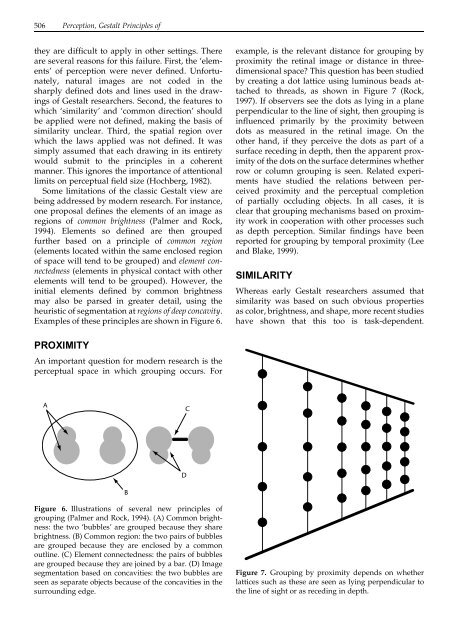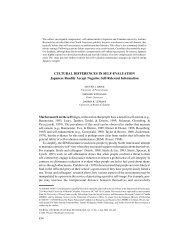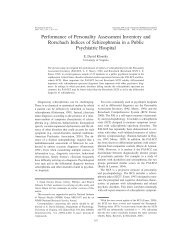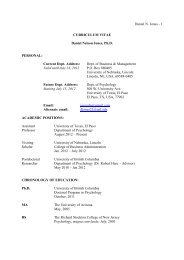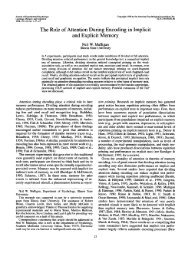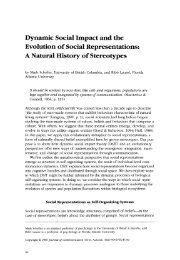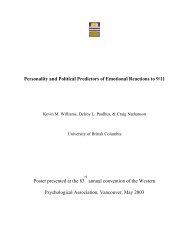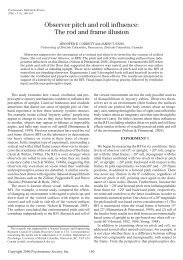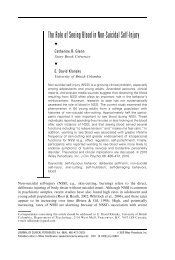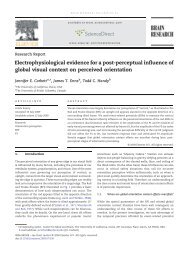Gestalt Grouping Principles - HomePage Server for UT Psychology
Gestalt Grouping Principles - HomePage Server for UT Psychology
Gestalt Grouping Principles - HomePage Server for UT Psychology
You also want an ePaper? Increase the reach of your titles
YUMPU automatically turns print PDFs into web optimized ePapers that Google loves.
506 Perception, <strong>Gestalt</strong> <strong>Principles</strong> of<br />
they are difficult to apply in other settings. There<br />
are several reasons <strong>for</strong> this failure. First, the `elements'<br />
of perception were never defined. Un<strong>for</strong>tunately,<br />
natural images are not coded in the<br />
sharply defined dots and lines used in the drawings<br />
of <strong>Gestalt</strong> researchers. Second, the features to<br />
which `similarity' and `common direction' should<br />
be applied were not defined, making the basis of<br />
similarity unclear. Third, the spatial region over<br />
which the laws applied was not defined. It was<br />
simply assumed that each drawing in its entirety<br />
would submit to the principles in a coherent<br />
manner. This ignores the importance of attentional<br />
limits on perceptual field size (Hochberg, 1982).<br />
Some limitations of the classic <strong>Gestalt</strong> view are<br />
being addressed by modern research. For instance,<br />
one proposal defines the elements of an image as<br />
regions of common brightness (Palmer and Rock,<br />
1994). Elements so defined are then grouped<br />
further based on a principle of common region<br />
(elements located within the same enclosed region<br />
of space will tend to be grouped) and element connectedness<br />
(elements in physical contact with other<br />
elements will tend to be grouped). However, the<br />
initial elements defined by common brightness<br />
may also be parsed in greater detail, using the<br />
heuristic of segmentation at regions of deep concavity.<br />
Examples of these principles are shown in Figure 6.<br />
example, is the relevant distance <strong>for</strong> grouping by<br />
proximity the retinal image or distance in threedimensional<br />
space? This question has been studied<br />
by creating a dot lattice using luminous beads attached<br />
to threads, as shown in Figure 7(Rock,<br />
1997). If observers see the dots as lying in a plane<br />
perpendicular to the line of sight, then grouping is<br />
influenced primarily by the proximity between<br />
dots as measured in the retinal image. On the<br />
other hand, if they perceive the dots as part of a<br />
surface receding in depth, then the apparent proximity<br />
of the dots on the surface determines whether<br />
row or column grouping is seen. Related experiments<br />
have studied the relations between perceived<br />
proximity and the perceptual completion<br />
of partially occluding objects. In all cases, it is<br />
clear that grouping mechanisms based on proximity<br />
work in cooperation with other processes such<br />
as depth perception. Similar findings have been<br />
reported <strong>for</strong> grouping by temporal proximity (Lee<br />
and Blake, 1999).<br />
SIMILARITY<br />
Whereas early <strong>Gestalt</strong> researchers assumed that<br />
similarity was based on such obvious properties<br />
as color, brightness, and shape, more recent studies<br />
have shown that this too is task-dependent.<br />
PROXIMITY<br />
An important question <strong>for</strong> modern research is the<br />
perceptual space in which grouping occurs. For<br />
A<br />
C<br />
D<br />
B<br />
Figure 6. Illustrations of several new principles of<br />
grouping (Palmer and Rock, 1994). (A) Common brightness:<br />
the two `bubbles' are grouped because they share<br />
brightness. (B) Common region: the two pairs of bubbles<br />
are grouped because they are enclosed by a common<br />
outline. (C) Element connectedness: the pairs of bubbles<br />
are grouped because they are joined by a bar. (D) Image<br />
segmentation based on concavities: the two bubbles are<br />
seen as separate objects because of the concavities in the<br />
surrounding edge.<br />
Figure 7. <strong>Grouping</strong> by proximity depends on whether<br />
lattices such as these are seen as lying perpendicular to<br />
the line of sight or as receding in depth.


